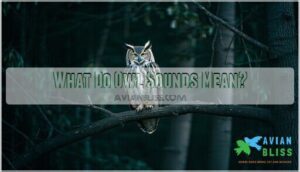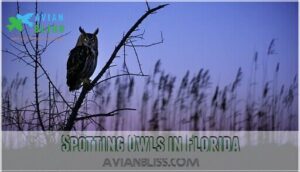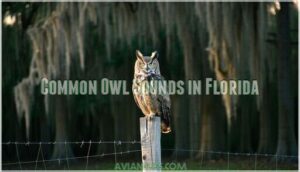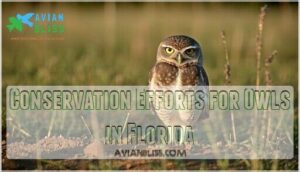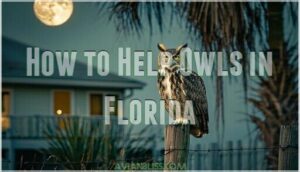This site is supported by our readers. We may earn a commission, at no cost to you, if you purchase through links.
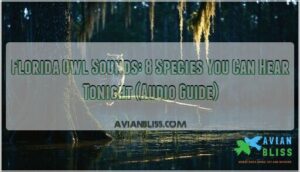
The Barred Owl’s famous "who-cooks-for-you" call dominates swamplands, while Great Horned Owls deliver deep, resonant hoots from pine forests.
Eastern Screech Owls produce haunting trills that’ll make your hair stand on end, and Barn Owls screech like something from a horror movie.
Burrowing Owls chatter near open fields, Short-eared Owls bark during twilight hunts, and the rare Northern Saw-whet Owl sounds like a rusty gate.
Even rarer Snowy Owls occasionally visit with their deep hoots.
Each species uses unique vocalizations for territory claims, mating calls, and communication.
Timing and location hold the keys to identifying these mysterious nighttime voices, especially when considering the unique vocalizations.
Table Of Contents
- Key Takeaways
- Types of Owls in Florida
- Owl Sounds and Identification
- What Do Owl Sounds Mean?
- Spotting Owls in Florida
- Common Owl Sounds in Florida
- Threats to Owl Populations in Florida
- Conservation Efforts for Owls in Florida
- How to Help Owls in Florida
- Unique Characteristics of Florida Owls
- Frequently Asked Questions (FAQs)
- What is the most common owl in Florida?
- Which owl makes the hoo hoo sound?
- Which owls hoot at night?
- What do different owl sounds mean?
- Can owls mimic human sounds or other animals?
- Do Florida owls migrate seasonally?
- How do weather conditions affect owl calls?
- Are owl sounds different between males and females?
- Can owls learn new sounds throughout their lives?
- How far can owl calls travel at night?
- Conclusion
Key Takeaways
- You’ll easily identify Florida’s eight owl species by their distinctive calls – from the Barred Owl’s famous "who-cooks-for-you" question to the Great Horned Owl‘s deep foghorn-like hoots and the Eastern Screech Owl’s haunting horse-like whinny.
- You’ll have the best success spotting owls during dawn and dusk hours in their preferred habitats – listen for Barred Owls near swampy woodlands, Great Horned Owls in pine forests, and Burrowing Owls in open grasslands and golf courses.
- You’re hearing complex communication when owls call – their hoots, screeches, and trills serve specific purposes including territorial defense, mate attraction, family communication, and warning calls to protect their young.
- You can help protect Florida’s owl populations by creating bird-friendly environments with native plants, reducing pesticide use, installing nest boxes, and supporting conservation efforts that combat habitat loss and human disturbance.
Types of Owls in Florida
You’ll encounter eight distinct owl species throughout Florida’s diverse habitats, from the tiny Eastern Screech Owl in your backyard to the impressive Great Horned Owl in wooded areas.
Each species has adapted to specific environments across the state, whether they’re year-round residents like the Barred Owl or occasional winter visitors like the Snowy Owl.
Eastern Screech Owl
You’ll find the Eastern Screech Owl thriving in Florida’s suburban neighborhoods, making it perfect for backyard bird watching.
This compact owl, standing just 6-9 inches tall, demonstrates remarkable Urban Adaptation skills. Listen for their distinctive whinnying call that sounds like a horse on helium – it’s unmistakable among owl sounds Florida offers.
Their hearing is most sensitive within the 4-5.7 kHz range, allowing them to effectively hunt prey.
Key features of this adaptable species:
- Color Morphs: Displays brown or reddish-brown plumage variations
- Cavity Roosts: Uses tree holes and nest boxes for shelter
- Diet Variations: Hunts insects, small rodents, and amphibians
- Backyard Habitats: Thrives in residential areas with mature trees
Barred Owl
Ever wondered what owl sounds like a curious chef? Barred Owls call out "Who cooks for you? Who cooks for you-all?" making them easy to identify among Florida owl sounds.
These territorial birds defend wooded areas near water, where their varied diet includes fish, frogs, and small mammals.
| Characteristic | Details | Notes |
|---|---|---|
| Call Pattern | "Who cooks for you?" rhythm | Last syllable drawn out longest |
| Habitat | Dense forests near water | Expanding range westward |
| Diet | Fish, frogs, small mammals | Opportunistic hunters |
| Territory | Year-round territorial | Especially during nesting |
| Conservation | Stable populations | Competing with spotted owls |
Great Horned Owl
After sunset, the Great Horned Owl’s deep hoots echo through Florida’s woodlands like a natural foghorn.
This powerful predator showcases remarkable dietary adaptations, hunting everything from skunks to small birds.
Their distinctive ear tufts and yellow eyes make owl identification easier than other species.
- Vocalization Analysis: Deep, resonant hoots carry over long distances for territorial claims
- Nesting Habits: Occupies abandoned hawk or crow nests in tall trees
- Geographic Distribution: Found statewide in diverse Florida habitats year-round
Barn Owl
While Great Horned Owls command attention with deep hoots, Barn Owls offer something completely different.
You’ll recognize their ghostly white heart-shaped faces and piercing screeches that sound like k-r-r-r-r-ick echoing through Florida’s open grasslands and farmland.
| Feature | Details | Notes |
|---|---|---|
| Barn Owl Diet | Small rodents, insects | Exceptional night hunters |
| Nesting Habits | Tree cavities, buildings | Use regurgitated pellets |
| Habitat Preference | Open fields, marshes | Least common Florida species |
| Conservation Status | Stable but declining | owl identification requires patience |
These owl sounds Florida enthusiasts treasure represent nature’s most efficient pest controllers, making owl calls Florida nights unforgettable experiences.
Burrowing Owl
Florida’s ground-dwelling Burrowing Owl breaks owl stereotypes with its underground lifestyle and daylight hunting habits.
You’ll hear their gentle "coo cooooo" calls across open spaces, but these threatened birds offer much more.
- Diurnal Activity: Active during both day and night hours
- Mimicry Behavior: Imitates rattlesnake sounds for burrow defense
- Burrowing Diet: Hunts insects and small rodents near ground level
- Florida Threats: Habitat loss threatens their survival statewide
Short-Eared Owl
Unlike other Florida owl species, the Short-Eared Owl follows unique migration patterns, visiting during winter months.
You’ll spot their identifying features: streaked brown plumage and small ear tufts.
Their habitat preference for open grasslands differs from forest-dwelling cousins.
These owls practice diurnal hunting, actively searching fields during daylight hours.
Their conservation status reflects declining populations, making winter sightings special treats for Florida birds enthusiasts seeking diverse owl sounds.
They favor large grassland expanses for breeding.
Northern Saw-Whet Owl
Beyond the Short-Eared Owl’s open-field hunting, you’ll discover the Northern Saw-Whet Owl’s secretive forest lifestyle.
These tiny owls produce distinctive "too-too-too" whistles during breeding season, making Saw-whet Identification challenging outside winter months.
- Habitat Preference: Dense coniferous forests
- Diet Analysis: Small mammals and mice
- Conservation Status: Stable populations despite habitat threats
Snowy Owl
You’ll rarely encounter a Snowy Owl in Florida, but these Arctic Origins visitors occasionally appear during harsh northern winters.
Their distinctive Snowy Plumage makes identification easy against Florida’s landscape. These Winter Visitors showcase remarkable Prey Specialization, primarily hunting lemmings in their native habitat.
Climate Impacts drive their southern migrations, making any Florida owls sighting extraordinary for owl identification enthusiasts tracking owl sounds and owl calls.
| Characteristic | Details |
|---|---|
| Size | 20-27 inches tall, wingspan 4.2-4.8 feet |
| Plumage | White with varying dark bars |
| Habitat | Open fields, airports, beaches |
| Diet | Small mammals, waterfowl |
| Migration | Irregular irruptive movements south |
Owl Sounds and Identification
Mastering owl identification Florida starts with understanding their distinct vocalizations.
Each species creates unique acoustic signatures that reveal their identity in the darkness.
Listen for these key Florida owl sounds:
- Eastern Screech-Owl’s haunting trill – resembles a horse’s whinny on helium
- Great Horned Owl’s deep hoots – sounds like a muffled foghorn echoing through trees
- Barn Owl’s piercing screech – sharp, almost alien-like warning calls
- Barred Owl’s rhythmic "who-cooks-for-you" – unmistakable conversational cadence
Sound variations and species dialects make acoustic monitoring fascinating, turning owl sounds guide expertise into your nighttime superpower.
Owls use calls for territory and mating.
What Do Owl Sounds Mean?
When you hear an owl’s call echoing through Florida’s night air, you’re listening to a complex language of territory claims, mate attraction, and family communication.
Each hoot, screech, and trill serves a specific purpose, from the Great Horned Owl’s deep territorial announcements to the Barn Owl’s sharp warning calls that protect their young, which is a key aspect of their family communication.
Hooting Sounds
When darkness falls across Florida, hooting sounds become nature’s territorial announcements.
Hooting functions as owls’ primary communication method, with species variations creating distinct acoustic signatures.
Great Horned Owls deliver deep, resonant calls while Barred Owls perform their famous "Who cooks for you?" melody.
Duet hooting between mated pairs strengthens bonds, and hooting frequency peaks during breeding season when these Florida owl sounds echo through wetlands and forests.
Screeching Sounds
Sharp screeching sounds slice through Florida’s darkness, signaling more than just spooky night vibes.
Listen closely—those eerie midnight screeches aren’t just Halloween sound effects, they’re owls conducting serious business in the shadows.
When you hear these piercing calls, you’re witnessing owl communication at its most intense.
Barn owl screeches and eastern screech owl sounds serve as territorial warnings, distress calls, or hunting announcements.
- **Screeching variations indicate different messages—from "stay away" territorial screeches to urgent distress calls during threats.
Whistling Sounds
While most Florida owls rely on hoots and screeches, some species produce distinctive whistling sounds that’ll catch your ear.
Eastern Screech-Owls create soft, musical whistles during courtship, while young owls often whistle to communicate with parents.
These gentle owl whistles differ greatly between species, with each having evolved unique whistle meaning for survival and social bonding.
Chattering Sounds
Chatter erupts when Florida’s owls engage in complex social exchanges. These rapid-fire vocalizations reveal territorial disputes, family communication, and threat responses across different species.
- Juvenile chatter – Young owls begging for food from parents
- Species-specific chatter – Each owl type has distinct chattering patterns
- Contextual variations – Meaning changes based on season and situation
- Threat response – Aggressive chatter warns off intruders
- Florida birds sounds – Chattering blends with other nocturnal wildlife calls
Other Unique Sounds
Beyond typical hoots, Florida’s owls produce fascinating defensive mimicry sounds that’ll surprise you.
Burrowing owls imitate rattlesnake hisses when threatened, while barn owls create blood-curdling screams.
You’ll hear juvenile calls begging for food, sharp alarm calls warning of danger, and soft contact calls between mates.
Different subspecies dialects add regional variations to these owl vocalizations, creating a rich symphony of types of owl sounds throughout Florida’s nights.
Spotting Owls in Florida
You’ll have better luck spotting Florida’s owls by listening first, since their nocturnal habits and excellent camouflage make visual sightings challenging even for experienced birders.
Your best strategy involves visiting their preferred habitats during dawn and dusk hours when they’re most active, using their distinctive calls to locate them before attempting to spot their silhouettes against the sky.
Best Time to Spot Owls
Timing transforms your owl-watching success. Peak owl activity occurs during twilight hours when prey availability soars and vocalizations echo through Florida’s landscapes. Optimal time is during crepuscular hours.
- Dawn and dusk periods: Owls hunt actively as small mammals emerge, creating perfect conditions for hearing owl sounds at night.
- New moon phases: Darker skies encourage bolder owl hooting sounds and increased movement.
- Cool, calm evenings: Minimal wind carries owl vocalizations farther across open areas.
Best Places to Spot Owls
Perfect owl-watching spots await you across Florida’s diverse landscapes.
Urban Owl Havens like Central Park in Winter Park offer convenient access, while Rural Owl Habitats such as Paynes Prairie Preserve provide expansive territories. Coastal Owl Spots along the Gulf Coast attract migrating species during winter months.
| Habitat Type | Top Locations |
|---|---|
| Florida Parks | Everglades National Park, Myakka River State Park |
| Refuge Hotspots | Merritt Island National Wildlife Refuge, Corkscrew Swamp Sanctuary |
| Urban Areas | Bok Tower Gardens, Lettuce Lake Park |
These Florida wildlife sanctuaries maximize your chances of encountering owl species Florida residents love hearing after dark.
Tips for Spotting Owls
Listen carefully during dawn/dusk hours when Florida’s owls are most active.
Look upwards in their preferred habitats—wooded areas near water for Barred Owls, open fields for Burrowing Owls. Watch for their silent flight patterns and use habitat clues like pellets beneath trees.
Identifying owl calls is easier than spotting them visually. Remember, patience pays off in owl watching Florida adventures when you’re tuned into owl sounds at night.
Enhancing visibility can be achieved using specialized viewing equipment.
Common Owl Sounds in Florida
You’ll recognize Florida’s owls more easily by their distinctive calls than by sight, since these nocturnal hunters prefer the cover of darkness.
The five resident species each produce unique vocalizations, from the Great Horned Owl’s deep hoots that sound like a muffled foghorn to the Barred Owl’s rhythmic "Who cooks for you?" call.
Great Horned Owl Sounds
The Great Horned Owl’s deep, resonant hoots echo through Florida’s darkness like nature’s foghorn.
These powerful owl calls showcase remarkable vocalization complexity and sound variation across different regions.
- Deep hooting sequences – Classic "hoo-hoo-hoooo" territorial defense calls
- Pair bonding duets – Females and males chant together harmoniously
- Geographic dialects – Subtle regional differences in pitch and rhythm
- Seasonal variations – Intensified calling during winter breeding months
Barred Owl Sounds
Unlike the Great Horned Owl’s deep hoots, Barred Owls produce their famous "Who cooks for you? Who cooks for you-all?" call.
These distinctive barred owl sounds serve essential functions in mating calls and territorial defense.
Their acoustic range extends far through Florida’s woodlands, with call variations including chatters and cackles.
| Call Type | Purpose | Sound Description |
|---|---|---|
| Classic Hoot | Territorial Defense | "Who cooks for you?" |
| Mating Call | Courtship | Extended hooting sequence |
| Alarm Call | Warning | Sharp barks and cackles |
| Contact Call | Family Communication | Soft hoots |
Eastern Screech Owl Sounds
The eastern screech owl produces Florida’s most distinctive urban owl sounds through two primary vocalizations.
You’ll hear their haunting whinny call echoing through suburban neighborhoods, followed by gentle trills that sound like a horse on helium.
These screech-owl communication patterns vary between males and females, with regional sound variation across different Florida habitats.
Key Eastern Screech Owl Sound Characteristics:
- Whinny call serves territorial defense and general communication
- Trill represents intimate family contact and mating calls
- Sound frequency analysis reveals males call at lower pitches
- Florida wildlife sounds include both red and gray morph vocalizations
- Owl calls mp3 recordings capture their distinctive descending patterns
Barn Owl Sounds
Barn Owls produce spine-tingling shrieks that’ll make you question what’s lurking in Florida’s darkness.
Their high-pitched k-r-r-r-r-ick calls and longer territorial shrieks sound almost human-like, creating an unsettling symphony across open fields.
These nocturnal hunters use their communication range effectively, with distress calls warning of danger and screech variations advertising their presence to other owls.
Owls play a pivotal role in the ecosystem by controlling rodent populations.
- Download owl sounds mp3 recordings to familiarize yourself with their eerie vocalizations
- Study pellet analysis near barn sites to understand their hunting patterns and diet
- Listen for Florida wildlife sounds during peak activity hours at dawn and dusk
Burrowing Owl Sounds
Out in Florida’s open grasslands, you’ll hear the Burrowing Owl’s distinctive "coo-coooo" call with its gentle wheeze.
These ground-dwelling birds use coo variations for burrow communication and territorial defense.
When threatened, they employ defense mechanisms including rattlesnake mimicry to deter predators.
Juvenile vocalizations differ from adults, creating a chorus in family groups.
Listen for these unique burrowing owl sounds on golf courses and vacant lots—owl sound recordings help distinguish their calls from other Florida owls.
Threats to Owl Populations in Florida
You’ll find that Florida’s owls face mounting pressures from habitat loss, climate change, and human interference that threaten their survival across the state.
These challenges affect everything from their nesting sites to prey availability, making conservation efforts essential for maintaining the haunting calls you hear on those quiet Florida nights.
Habitat Loss and Fragmentation
Development pressure transforms Florida’s landscapes faster than you can say "Who cooks for you?" Urban sprawl fragments owl habitats into isolated patches, while agricultural expansion eliminates hunting grounds.
This transformation results in wetland loss and forest degradation, forcing owls into smaller territories with reduced prey.
The connectivity reduction that occurs makes it harder for owls to find mates and establish new territories, directly impacting their ability to thrive.
Habitat loss directly impacts where you’ll hear those distinctive owl sounds echoing through Florida nights.
Climate Change
Rising temperatures and shifting weather patterns threaten Florida’s owl populations in ways that’ll surprise you.
Climate change creates a domino effect that disrupts these nocturnal hunters’ entire way of life.
Here’s how climate change impacts Florida’s owls:
- Nesting Impacts – Extreme heat waves during spring breeding season reduce hatching success rates
- Prey Abundance – Drought conditions decrease rodent populations, forcing owls to hunt harder for food
- Migration Shifts – Changing temperatures alter traditional movement patterns, especially for Short-eared Owls
- Habitat Changes – Sea level rise threatens coastal territories where owls nest and roost
- Sound Alterations – Environmental stress changes owl calls, affecting owl sound recordings and behavioral studies
Human Disturbance
Every night, light pollution from streetlights and buildings disrupts owls’ hunting abilities, while noise pollution from traffic masks their essential owl calls.
Vehicle collisions and habitat encroachment from development force these birds into dangerous situations.
Chemical exposure from pesticides further weakens populations.
When analyzing owl sounds recordings, you’ll notice fewer calls in areas with heavy human disturbance.
Conservation efforts aim to mitigate these effects by protecting owl habitats.
Conservation Efforts for Owls in Florida
You can support Florida’s owl populations through habitat restoration programs, wildlife corridors, and organizations working to protect nesting sites from urban development.
These conservation efforts focus on preserving the diverse ecosystems that owls need to thrive, from wetlands for Barred Owls to open grasslands for the threatened Burrowing Owl.
Protecting Habitats
Beyond addressing immediate threats, protecting Florida owls requires thorough habitat restoration efforts across the state.
You can witness firsthand how land acquisition programs actively preserve critical owl habitats throughout Peninsular Florida, while sustainable forest management practices enhance nesting territories for these nocturnal hunters.
Wildlife corridors now connect fragmented landscapes, creating safe passages between owl populations. Urban sprawl continues challenging these efforts, but artificial burrow installations successfully support displaced burrowing owl communities, particularly in Cape Coral’s protected colonies.
Here’s how habitat protection works:
- Native landscaping requirements maintain natural owl-friendly environments in developing areas
- Fire management practices preserve ideal hunting grounds for Florida owls
- Private landowner partnerships expand protected territories through voluntary conservation easements
These coordinated efforts build climate resilience while reducing habitat loss statewide.
Reducing Human Disturbance
Why does your backyard’s bright security light keep Florida’s owls awake at night? Light pollution disrupts their natural hunting patterns and nesting behaviors.
You can make a real difference by installing motion-sensor lighting and using amber bulbs instead of harsh white ones.
Noise reduction during breeding season protects vulnerable owl families. Keep lawn mowing and construction work for daytime hours when possible.
| Disturbance Type | Simple Solution |
|---|---|
| Bright outdoor lighting | Motion sensors, amber bulbs |
| Lawn equipment noise | Daytime use only |
| Responsible tourism visits | Maintain 50-foot distance |
| Construction sounds | Avoid dawn/dusk hours |
| Pesticide applications | Use owl-friendly alternatives |
Awareness campaigns help neighbors understand how human disturbance affects owl behavior and bird sounds.
Supporting Conservation Organizations
Beyond reducing disturbance, you can amplify your impact by supporting owl conservation organizations directly.
Groups like the American Bird Conservancy offer volunteer opportunities in field research and habitat monitoring.
Your donations fund research grants that advance owl science, while advocacy efforts protect critical nesting sites.
Community engagement through these organizations strengthens wildlife conservation initiatives, ensuring Florida’s distinctive owl sounds continue echoing through our forests.
How to Help Owls in Florida
You can make a real difference for Florida’s owl populations by creating bird-friendly spaces in your own backyard and reducing harmful pesticides that affect their prey.
Simple actions like installing nest boxes, maintaining native plants, and supporting local conservation groups help protect these magnificent nocturnal hunters for future generations, which is a crucial step in preserving the magnificent wildlife.
Creating a Bird-Friendly Environment
Transform your yard into an owl sanctuary by planting native plants that attract prey and provide shelter.
Install nesting boxes 12-15 feet high in mature trees, facing away from prevailing winds. Add water sources like shallow birdbaths or small ponds for drinking and bathing.
Focus on reducing hazards by keeping cats indoors and turning off unnecessary outdoor lights that disrupt nocturnal hunting patterns.
These owl-friendly environments support healthy populations while letting you enjoy their mesmerizing owl calls nightly. You can easily find plants for sale online to enhance your yard.
Reducing Pesticide Use
Ditch harmful pesticides to protect Florida’s owl populations and their food web.
When you spray chemicals, you’re poisoning the insects and rodents that owls depend on for survival.
Switch to integrated pest management and natural pesticide alternatives instead.
Your yard becomes a safer habitat where owls can hunt without encountering toxic prey.
This simple change supports owl conservation while maintaining effective rodent control naturally.
Supporting Conservation Efforts
Why settle for just listening to owl sounds when you can actively protect the birds behind those haunting calls?
Supporting conservation efforts transforms you from passive observer to active guardian of Florida’s nocturnal hunters. Your involvement directly combats habitat loss and strengthens owl protection initiatives across the state.
Here’s how you can make a real difference in owl conservation:
- Join citizen science projects that monitor owl populations and track their territorial calls
- Support habitat protection organizations working to preserve critical nesting areas
- Participate in education outreach programs that teach others about bird conservation
- Donate to research initiatives studying the impact of reducing pesticides on owl health
Every action strengthens the future of these remarkable nocturnal creatures.
Unique Characteristics of Florida Owls
You’ll discover that Florida’s owls display remarkable adaptations, from the Burrowing Owl’s underground lifestyle to the Barn Owl’s heart-shaped face that acts like a satellite dish for detecting prey.
These nocturnal hunters have evolved distinct physical features, hunting strategies, and habitat preferences that make each species perfectly suited to Florida’s diverse ecosystems.
They have unique characteristics, such as the nocturnal hunters trait, that enable them to thrive in their environments.
Physical Characteristics
Across Florida’s landscapes, owl physical characteristics reveal nature’s remarkable engineering.
Owl sizes span dramatically—burrowing owls stand under 9 inches while great horned owls tower at 25 inches.
Their eye color ranges from brilliant yellow to deep brown, positioned frontally for superior depth perception.
Feather patterns showcase intricate mottled browns, striking whites, and distinctive barring that provides perfect camouflage.
Some species display prominent ear tufts, while others feature longer leg length for ground-dwelling lifestyles.
These adaptations make owl species perfectly suited for their hunting environments.
Behavioral Characteristics
Florida’s owls showcase remarkable behavioral patterns that make them fascinating nocturnal neighbors.
Their territorial defense strategies include distinctive owl calls that echo through the night, while complex mating rituals involve synchronized duetting between pairs.
You’ll discover these intriguing behaviors when observing Florida’s owls:
- Nocturnal hunting expeditions using silent flight and precise swooping attacks from elevated perches
- Social behavior variations, from solitary Great Horned Owls to communal Burrowing Owl families
- Nesting habits that include cavity selection, burrow digging, and protective parental instincts
- Owl vocalization analysis reveals territorial boundaries, mate attraction calls, and family communication systems
Habitat Preferences
Beyond their distinctive behaviors, Florida owls showcase remarkable habitat diversity across the state’s varied landscapes.
Each species has evolved specific nesting locations and roosting habits that maximize their survival success.
Urban adaptation varies dramatically among Florida’s owl populations.
Eastern Screech-Owls thrive in neighborhoods, using backyard nest boxes, while Burrowing Owls prefer golf courses and vacant lots.
Great Horned Owls demonstrate exceptional flexibility, adapting from dense forests to city parks.
| Species | Preferred Habitat | Territory Size |
|---|---|---|
| Barred Owl | Swampy woodlands near water | 1-2 square miles |
| Burrowing Owl | Open grasslands, airports | 1-6 acres |
| Barn Owl | Agricultural fields, abandoned buildings | 2-4 square miles |
Understanding bird habitat preferences helps with owl sounds analysis and supports vital habitat conservation efforts.
Frequently Asked Questions (FAQs)
What is the most common owl in Florida?
You’ll most likely hear Great Horned Owls throughout the state.
They’re Florida’s largest breeding owl species, adapting to diverse habitats from wooded areas to parks.
They make their deep hoots the most familiar owl sound you’ll encounter, which is a key characteristic of their presence.
Which owl makes the hoo hoo sound?
Great Horned Owls make the classic "hoo hoo" sound you’re thinking of.
Their deep, resonant hoots carry far distances and sound like a muffled foghorn.
You’ll often hear pairs calling together during mating season.
Which owls hoot at night?
As the saying goes, "the night comes alive" when you’re listening for Florida’s hooting owls.
You’ll hear Great Horned Owls with their deep, resonant calls and Barred Owls asking "**Who cooks for you?
**" after dark.
What do different owl sounds mean?
Owl sounds communicate territory, attract mates, and maintain contact with family.
You’ll hear deep hoots for claiming space, trills for courtship, screeches for warnings, and soft calls for parent-chick communication during nesting season, which involves parent-chick communication.
Can owls mimic human sounds or other animals?
Most owls can’t mimic human speech like parrots, but they’re surprisingly good at copying other sounds.
You’ll hear them imitate different bird calls, and burrowing owls even mimic rattlesnake sounds to scare away predators from their burrows.
Do Florida owls migrate seasonally?
Most Florida owls stay put year-round, but you’ll spot short-eared owls only during winter months when they migrate south.
These seasonal visitors hunt during daylight hours across open farmland and airports.
How do weather conditions affect owl calls?
Like nature’s symphony conductor, weather dramatically shapes your owl-listening experience.
Rain muffles their calls, wind carries hoots farther, and cold air makes sounds crisper.
You’ll hear clearer calls on calm, cool nights when conditions favor sound travel.
Are owl sounds different between males and females?
Yes, you’ll notice distinct differences between male and female owl calls.
Males typically produce deeper, lower-pitched hoots, while females generate higher-pitched sounds.
This vocal dimorphism helps with mate recognition and territorial communication.
Can owls learn new sounds throughout their lives?
You’ll find that owls can indeed learn new sounds throughout their lives, though they’re not as vocal mimics as parrots.
They adapt their calls for specific situations and can modify vocalizations based on environmental changes, which allows them to be more effective in their communication.
How far can owl calls travel at night?
Before telegraphs carried messages across vast distances, owl calls traveled impressively far through night air.
You’ll hear Great Horned Owl hoots up to two miles away, while smaller screech owls reach about half a mile in ideal conditions.
Conclusion
Like a naturalist’s symphony conductor, you’ve now learned to distinguish between Florida’s eight owl species through their unique vocal signatures.
These florida owl sounds serve as your nighttime compass, guiding you through the state’s diverse ecosystems from swamplands to pine forests.
Whether you hear the Barred Owl’s distinctive "who-cooks-for-you" or the Eastern Screech Owl’s haunting trill, you’re equipped to identify these mysterious nocturnal hunters and appreciate their essential role in Florida’s wildlife community with a deeper understanding of their nocturnal behaviors.
- https://www.allaboutbirds.org/guide/Barred_Owl/sounds
- https://www.audubon.org/field-guide/bird/barred-owl
- https://www.quora.com/How-can-I-tell-if-an-owl-is-hooting-at-night-or-a-different-bird-if-I-cant-see-it
- https://abcbirds.org/blog21/owl-sounds/
- https://blogs.ifas.ufl.edu/polkco/2019/11/06/commonly-confused-owls-in-florida/








